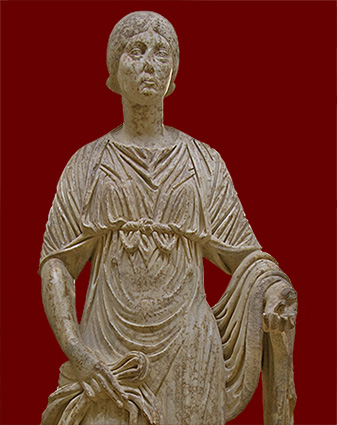
Matrona, local marble, early 3rd century CE (full statue)
CIL 8.152
The memory of Urbanilla, a Roman citizen of Africa Proconsularis, is preserved in this epitaph inscribed on the side of her mausoleum and dedicated by her devoted husband Lucius. Dated to the early third century CE, the inscription tells us little about her beyond the fact that she was a respectable, much-loved matrona who filled the roles of both coniunx and comes negotiorum — wife and business partner — for her husband. It is not clear what form their business took, but it required negotiations in Rome; since the Tunisian plains were abundant in olive trees, the couple may have been merchants of olives or oil. In the form of a nine-line acrostic poem in often faulty dactylic hexameters, the initial letters of the epitaph are an acrostic, spelling out Urbanilla's name. Presumably written by her grieving husband (see line eight), the poem explains that upon their return home to North Africa from their business trip to Rome, Urbanilla died in Carthage. Her well-preserved stone mausoleum, dating to the second or third century CE, was decorated with Corinthian pilasters and once surrounded by a wall (there is no image available online); it was seen and its inscription was transcribed by two late nineteenth-century travelers at Sommet el Amra on the banks of the Semha river, a site between ancient Thala and Capsa in southwestern Tunisia, well over two hundred land miles south of Carthage. That Lucius buried his wife so far from the place of her death suggests that he and Urbanilla were born in or resided in that area. The mausoleum, which contained niches for additional burials, must have once contained a statue of her and her burial container bearing now lost information about her, including her full name and her husband's, her age, her family connections, and perhaps her social standing in the community (for example, see the second-century CE joint tomb and inscriptions for Julia Secunda and Cornelia Tyche).The epitaph is inscribed in large letters with no decoration except for the ivy leaf (hedera distinguens) found at the end of line four; the heart-shaped leaf is a variant of the interpunct (a medial dot separating words or syllables), found on epigraphic monuments from 79 CE (more commonly from the second half of the second century CE). Punctuation has been added to the text of the inscription to facilitate translation.
VRBANILLA, MIHI CONIVNX, VERECVNDIA PLENA HIC SITA EST.
ROMAE COMES NEGOTIORVM, SOCIA, PARSIMONIO FVLTA.
BENE GESTIS OMNIBVS, CVM IN PATRIA MECVM REDIRET,
AV MISERAM CARTHAGO MIHI ERIPVIT SOCIAM. 
5 NVLLA SPES VIVENDI MIHI SINE CONIVGE TALI.
ILLA DOMVM SERVARE MEAM ILLA ET CONSILIO IVVARE.
LVCE PRIVATA MISERA QVESCIT IN MARMORE CLVSA.
LVCIVS EGO CONIVNX HIC TE MARMORE TEXI.
Click on the underlined words for translation aids and commentary, which will appear in a small window. Click on the icon link![]() to the right of the line for related images and information.
to the right of the line for related images and information.